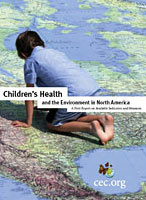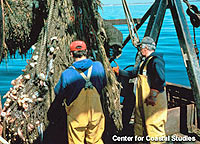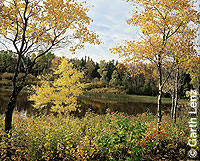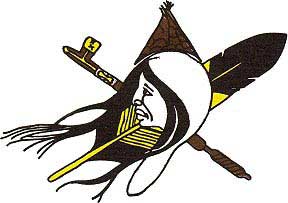
News |
- Children's Health Survey Released
- Groups File Suit to Protect Polar Bears
- Canadians Oppose Destructive Fishing Practice
- New Boreal Conservation Framework Supporters
- Lake Winnipeg 10-Year Funding
- MOU to Advance Boreal Protection
- Water Protection Act Proclaimed
- NRDC Issues Boreal BioGem Alert
- Wuskwatim Power License Update
- US Supreme Court Decides Wetlands Future
- Green and Growing - New Manitoba Strategy
- Asatiwisipe Aki Releases Lands Plan
| Children's Health Survey Released | 08 February 06 |
 The NAFTA Commission for Environmental Cooperation (CEC) has released a report on children's health and environmental indicators in North America. The report presents 13 indicators under three thematic areas: asthma and respiratory disease, effects of exposure to lead and other toxic substances, and waterborne diseases. The NAFTA Commission for Environmental Cooperation (CEC) has released a report on children's health and environmental indicators in North America. The report presents 13 indicators under three thematic areas: asthma and respiratory disease, effects of exposure to lead and other toxic substances, and waterborne diseases.The report notes a decrease in exposure to lead, but rising incidence of childhood asthma throughout North America. In Canada, four times more children have asthma now, compared with 20 years ago. "We now have an initial report card of 13 basic children's environmental health indicators," said Dr. Maria Neira of the WHO. "Indicators such as those identified in this report provide us with a tool that can help us identify the most important environmental health risks to children, and then target preventive actions which will save many lives." CEC Director William Kennedy says a uniform data set is essential if policy-makers are to adequately address risks to children's heath. View the January 26, 2006 CEC release View the CEC report: Children's Health and the Environment in North America View the January 27, 2006 CBC article View the January 27, 2006 Globe & Mail article Sources: Commission on Environmental Cooperation, Globe & Mail |
|
| Groups File Suit to Protect Polar Bears | 06 February 06 |
 A lawsuit filed under the US Endangered Species Act (ESA) December 2005 may force the US government to consider polar bears as a threatened species. A lawsuit filed under the US Endangered Species Act (ESA) December 2005 may force the US government to consider polar bears as a threatened species.The lawsuit, filed by the Center for Biological Diversity, Natural Resources Defense Council (NRDC) and Greenpeace contends that rising global temperatures are causing the unprecedented melting of Arctic sea ice. Polar Bears depend on sea ice for hunting, mating and travel. The suit asks the US Interior Department to bestow the broad federal protection of the Endangered Species Act upon polar bears by designating them as "threatened." If the lawsuit is successful, polar bears could become the first mammal to be officially declared at risk due to global warming. Listing under the US Endangered Species Act would provide broad protection to polar bears, including a requirement that US federal agencies ensure that any action carried out, authorized, or funded by the United States government will not "jeopardize the continued existence" of polar bears, or adversely modify their critical habitat. View the December 15, 2005 Greenpeace USA, Center for Biological Diversity & NRDC press release View the legal text of the complaint filed by the three conservation groups View Greenpeace US information on Polar Bears Visit the NRDC BioGems site on Polar Bears Visit the Center for Biological Diversity site on Polar Bears View the December 19, 2005 Reuters article on Planet Ark Sources: Greenpeace USA, Center for Biological Diversity, Natural Resources Defense Council, Reuters/Planet Ark |
|
| Canadians Oppose Destructive Fishing Practice | 06 February 06 |
 A national poll released by Greenpeace and the Ecology Action Centre shows 78% of Canadians believe Canada should support a moratorium on high seas bottom trawling in international waters, even if it may cost jobs. Greenpeace reports that internal DFO documents indicate Canada has actively worked on the international scene to oppose and undermine such a moratorium. A national poll released by Greenpeace and the Ecology Action Centre shows 78% of Canadians believe Canada should support a moratorium on high seas bottom trawling in international waters, even if it may cost jobs. Greenpeace reports that internal DFO documents indicate Canada has actively worked on the international scene to oppose and undermine such a moratorium.The United Kingdom, Mexico and Brazil are among the countries that currently support an international moratorium on high seas bottom trawling. Bottom trawlers use weighted underwater nets up to 100 metres wide that are dragged along the sea floor. Huge chains or rollers attached to the front of the nets damage or destroy everything in its path, including highly sensitive cold water coral and sponge forests. View the January 12, 2006 Greenpeace Canada release View the December 29, 2005 CTV article Source: Greenpeace Canada |
|
| New Boreal Conservation Framework Supporters | 01 February 06 |
 The Nature Conservancy and Ethical Funds Company announced their endorsement of the Boreal Forest Conservation Framework on December 19, 2005. The Nature Conservancy and Ethical Funds Company announced their endorsement of the Boreal Forest Conservation Framework on December 19, 2005.Prior to the December 2005 announcement, 11 conservation organizations, First Nations, and forestry and energy companies were signatory to the Boreal Forest Conservation Framework. The framework is a national vision that calls for the protection of at least 50% of Canada's 1.4 billion acre Boreal forest region. Ethical Funds has written to and begun talks with RBC Financial Group, CIBC, TD Bank Financial Group, Scotiabank Group and BMO Financial Group asking them to develop lending policies based on biodiversity protection, and that they endorse the Framework. View the full December 19, 2005 press release from the Canadian Boreal Initiative View the December 19, 2005 Forest Ethics News article View the December 16, 2005 Ethical Funds Company press release Source: Canadian Boreal Initiative |
|
| Lake Winnipeg 10-Year Funding | 01 February 06 |
 One hundred and twenty million dollars over 10 years has been committed by the federal Liberal Party to restore the health of Lake Winnipeg. One hundred and twenty million dollars over 10 years has been committed by the federal Liberal Party to restore the health of Lake Winnipeg.The funding is part of the 10 year, $1 billion comprehensive four-part strategy to clean-up problem areas of the St. Lawrence River basin and the Great Lakes announced January 7, 2006 in Montreal by Paul Martin. The Manitoba objectives in the National Ecosystem Initiative and Revitalization Plan are to:
View Manitoba Wildlands' Lake Winnipeg page on the Lake Winnipeg Federal/Provincial Implementation Committee report Source: Liberal Party of Canada |
|
| MOU to Advance Boreal Protection | 30 January 06 |
 The Canadian Boreal Initiative (CBI) and the Newfoundland and Labrador Environment and Conservation Ministry have signed a Memorandum of Understanding (MOU) to work cooperatively to advance the establishment of protected areas in the province's Boreal region. The Canadian Boreal Initiative (CBI) and the Newfoundland and Labrador Environment and Conservation Ministry have signed a Memorandum of Understanding (MOU) to work cooperatively to advance the establishment of protected areas in the province's Boreal region.The January 18, 2006 MOU represents a new partnership that recognizes significant opportunities for conservation and sustainable development in the Boreal regions of Newfoundland and Labrador, and reflects the government's commitment to protect the province's environment and natural heritage. Newfoundland and Labrador is the first provincial government to sign an MOU regarding the boreal forest with the Canadian Boreal Initiative. The Canadian Boreal Initiative is an independent organization working with industry, Aboriginal people and conservationists to link science, policy and conservation and protection activities in Canada's Boreal region. View the full January 18, 2006 Canadian Boreal Initiative press release Source: Canadian Boreal Initiative |
|
| Water Protection Act Proclaimed | 30 January 06 |
 Manitoba's Water Protection Act officially took effect New Year's Day, giving the provincial government greater power to protect water quality. Manitoba's Water Protection Act officially took effect New Year's Day, giving the provincial government greater power to protect water quality.The Act includes provisions to limit or restrict any type of activity near sensitive rivers or lakes. A Manitoba Water Council will be established, as will a new Fund to assist communities with water monitoring and water quality projects. The province has already started to move forward with the Act by introducing a discussion document in summer 2005 as a first step in the development of a regulation to establish water quality management zones for nutrients. A summary report on public comments is expected to be released early in 2006. Public meetings in February will review next steps for this regulation. View the January 2, 2006 Canadian Press article View Manitoba Wildlands' August 3, 2005 news item View Manitoba Wildlands Water Protection Act information on our Water pages Source: Canadian Press |
|
| NRDC Issues Boreal BioGem Alert | 26 January 06 |
 Manitoba's Premier is again being asked by the Natural Resources Defense Council to act immediately on requests for interim protection for boreal forest lands central to the future boreal World Heritage Site in Manitoba and Ontario, Canada. In January 2006 an updated alert was issued, addressed to Manitoba Premier Doer. Previous NRDC BioGem alerts in support of interim protection for these lands resulted in 60,000 letters to Manitoba Conservation Minister Struthers. Manitoba's Premier is again being asked by the Natural Resources Defense Council to act immediately on requests for interim protection for boreal forest lands central to the future boreal World Heritage Site in Manitoba and Ontario, Canada. In January 2006 an updated alert was issued, addressed to Manitoba Premier Doer. Previous NRDC BioGem alerts in support of interim protection for these lands resulted in 60,000 letters to Manitoba Conservation Minister Struthers.Manitoba cabinet ministers, and Premier Doer have repeatedly stated their support for the future World Heritage Site. The Atikaki-Woodland Caribou First Nations world heritage site nomination is also supported by Canada, and endorsed in a 2004 World Conservation Congress boreal conservation resolution.  Visit the NRDC Biogems website Take action to Preserve the Heart of the Boreal Forest Sources: NRDC |
|
| US Supreme Court Decides Wetlands Future | 24 January 06 |
 The U.S. Supreme Court will hear a case in February that could dramatically affect the future of more than half the 40 million hectares of wetlands remaining in the United States. Private property rights advocates are pushing for a narrower interpretation and implementation of the 1972 Clean Water Act. They say the federal government has too much authority to regulate activity on wetlands adjacent to tributaries that flow into navigable bodies of water. The U.S. Supreme Court will hear a case in February that could dramatically affect the future of more than half the 40 million hectares of wetlands remaining in the United States. Private property rights advocates are pushing for a narrower interpretation and implementation of the 1972 Clean Water Act. They say the federal government has too much authority to regulate activity on wetlands adjacent to tributaries that flow into navigable bodies of water.A coalition of environmental groups, and hunting and fishing advocacy groups - including Ducks Unlimited - have filed a friend-of-the-court brief siding with the Bush administration in defending the current use of the Clean Water Act. Also supporting the current implementation are the attorneys general of 34 states. "Wetlands, clean water and the opportunity to fish and hunt are legacies our children deserve," said Don Young, Executive Vice President of Ducks Unlimited. View the January 6, 2006 Ducks Unlimited USA release View the January 13, 2006 U.S. Newswire release View the January 16, 2006 Midland Daily News article Sources: Ducks Unlimited, U.S. Newswire, Midland Daily News |
|
| Green and Growing - New Manitoba Strategy | 24 January 06 |
 Manitoba's Department of Energy, Science and Technology unveiled new environmental policy for Manitoba January 12, 2006. Green and Growing - Building a Green and Prosperous Future for Manitoba Families is a Manitoba Government "green strategic framework". Manitoba's Department of Energy, Science and Technology unveiled new environmental policy for Manitoba January 12, 2006. Green and Growing - Building a Green and Prosperous Future for Manitoba Families is a Manitoba Government "green strategic framework".The seven areas of strategic priority are:
Protected areas commitments are also part of Green and Growing. The policy makes a commitment to permanently designate "five new, major protected areas by 2010." "We commend our government for its world heritage site commitments. We are surprised though, by an apparent lack of awareness in this new strategy, of existing Manitoba protected areas policy and commitments," Gaile Whelan Enns, director, Manitoba Wildlands, said. Visit Manitoba Energy, Science and Technology's Green and Growing web site Source: Government of Manitoba |
|
| Asatiwisipe Aki Releases Lands Plan | 19 January 06 |
 Poplar River First Nation (Asatiwisipe Aki) is pleased to release it's lands management plan, for Poplar River First Nation Traditional Territory. Poplar River First Nation has spent several years, based on the direction and knowledge of our elders, planning for the permanent protection and management of our traditional lands. Poplar River First Nation (Asatiwisipe Aki) is pleased to release it's lands management plan, for Poplar River First Nation Traditional Territory. Poplar River First Nation has spent several years, based on the direction and knowledge of our elders, planning for the permanent protection and management of our traditional lands.The Asatiwisipe Aki Management Plan is based on the best knowledge available in terms of forest, land, water, wildlife, plants and fish management. Protecting Poplar River First Nation traditional lands and the continuation of traditional practices are the combined goals for our community. The Poplar River traditional lands are situated immediately east near the top of Lake Winnipeg, and flowing to the Ontario border. The traditional territory is a fully intact, functioning boreal ecosystem where water systems and species relationships are complete and abundant. Archeological studies have confirmed First Nation presence and land use for up to 6000 years. Protection from industrial development through provincial regulation has been in place for 800,000 ha of Poplar River's traditional territory since spring 1999. Visit the Poplar River First Nation website Source: Poplar River First Nation |
|


 RSS Feeds:
RSS Feeds: A December 22, 2005 letter from Manitoba Water Stewardship states that the sole shareholder and only partner of the Wuskwatim Power Limited Partnership is currently Manitoba Hydro. The Limited Partnership is registered as a numbered company. According to the document, the partnership may be amended to include Nisichawayasihk Cree Nation (NCN) or an NCN-controlled entity but this would happen only after approval through referendum, of the Project Development Agreement by NCN members.
A December 22, 2005 letter from Manitoba Water Stewardship states that the sole shareholder and only partner of the Wuskwatim Power Limited Partnership is currently Manitoba Hydro. The Limited Partnership is registered as a numbered company. According to the document, the partnership may be amended to include Nisichawayasihk Cree Nation (NCN) or an NCN-controlled entity but this would happen only after approval through referendum, of the Project Development Agreement by NCN members.